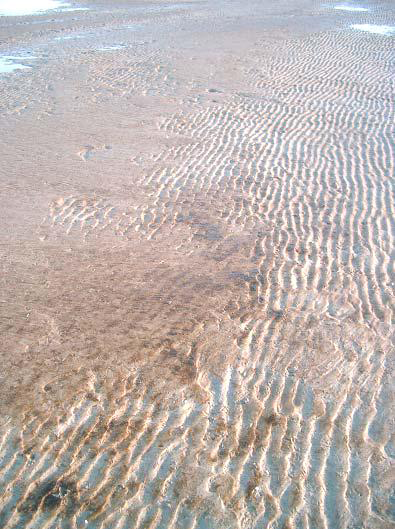About
In intertidal areas such as the Eastern Scheldt the bed roughness is not only influenced by abiotic factors (such as grain size, ripples and sand waves) but also by biotic factors (such as mussel beds, oyster reefs, diatom mats, lugworm fields and tube building worm fields) (Borsje, 2010). Diatom mats glue the sediment together and facilitate the deposition of fine sediment, resulting in a flat bed with a roughness height of several millimetres. Some biogenic structures like mussel reefs, oyster reefs and fields of tube building worms influence the roughness height directly. While other, such as lugworms, influence the roughness height indirectly. Lugworms excrete faecal matter on top of the sediment causing a topography of several centimetres.

Either by stabilizing or destabilizing the sediment, biological activity is able to modify the sediment fluxes by a factor 2 and more, compared to the solely physical case (Graf and Rosenberg, 1997). The direct effect of biota on sediment dynamics is demonstrated in different field studies (e.g. Widdows and Brinsley 2002; Le Hir et al., 2007), laboratory flume studies (e.g. Friedrichs et al., 2000; Bobertz et al., 2009) and different model studies (e.g. Paarlberg et al. 2007; Borsje et al., 2008). Apart from the direct influence of sediment (de)stabilization by biota, also indirect effects by biota are known to influence the sediment dynamics. The most important indirect effect by benthos is added roughness by biogenic structures to the bed (Friedrichs and Graf, 2009). Given the recolonisation of benthos after an intervention, the roughness will also vary temporally. Moreover, many biological processes show a seasonal variation. Lugworms for example show a much higher biomass in autumn compared to late winter (Beukema, 1974) and microphytobenthos show a peak in April and July (Cadée and Hegeman, 2002).
Tool description
The roughness tool is a first step in the translation of biological and physical roughness elements into hydrodynamics and sediment transport. Five different roughness elements are defined: diatom mats, mussel beds, lugworm fields, tube building worm fields and sand ripples. All these roughness elements have typical roughness heights, and are important to predict the hydrodynamics and sediment dynamics correctly.
| Roughness element | Roughness height k{}s* *[m] |
| Diatom mats | 0.01 |
| Tube building worms | 0.035 |
| Default roughness (the rest of the surface) | 0.075 |
| Lugworm | 0.12 |
| Sand ripples | 0.14 |
| Mussels | 0.15 |
Based on the roughness elements defined by the user this tool has the capability of creating a roughness height map. This map can be used as input for a hydrodynamic model (e.g. Delft3D) to investigate the impact of spatial varying roughness heights caused by biological features on the water level, flow velocity and bed shear stress.
